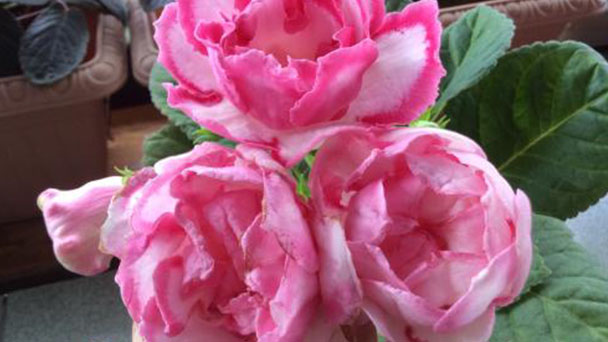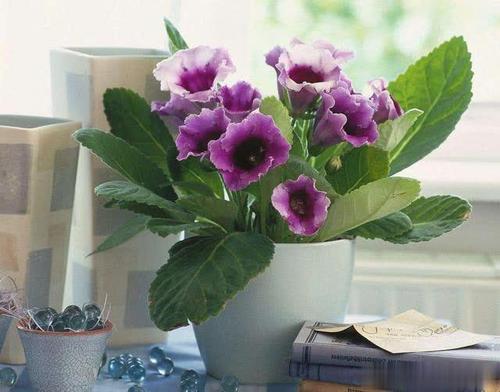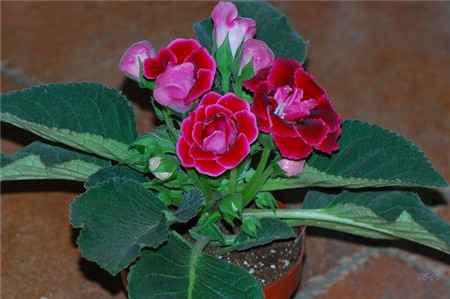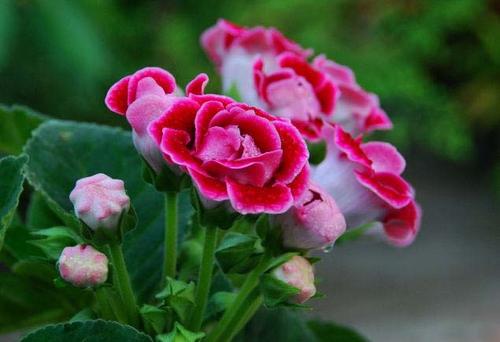Gloxinias profile
Written by Maggie
Jan 30 2021

Gloxinias (Sinningia speciosa) is a bulbous perennial flower of the Gesneriaceae genus Gloxinias. It has large, brightly colored flowers and is often used as a garden plant.Savanna of Brazil, South America.Gloxinias usually bloom in spring and summer.
Gloxinias picture

Morphological characteristics of Gloxinias
Gloxinias (Sinningia speciosa) is a perennial herb. The tubers are oblate and globose. The stems are very short on the ground, 15 -- 25cm in height. Leaves are opposite, thick and large,
Gloxinias are ovoid or oblong-elliptic, serrate; Leaves intervene, pedicels growing from between leaves. Flowers at the top or axillary, corolla bell shaped, apex round, 5-6 lobed color rich, pink, red, purple blue, white, polychrome and other colors, big and beautiful. Capsule seeds mature 1 month after anthesis; Seeds of gloxinias are brown, small and many.
Ecological habits of Gloxinias
Gloxinias (Sinningia speciosa) prefer warm and humid growth periods and avoid direct sunlight. It has a certain anti-heat ability, but it should be kept cool in summer. It is favorable for flowering at around 23℃, tubers in the temperature of 5℃ or so, can also be safe over the winter.Growth period requires high air humidity, do not like water, to avoid rain invasion; Winter dormant period should be kept dry, such as humidity is too large or the temperature is too low, the tuber is easy to rot. Gloxinias like fertile loose micro acid soil.
Wild in the tropical highlands where summers are cool and winters are warm. Gloxinias prefer warm, humid and semi-cloudy conditions during growth. High temperature and humidity in summer, unfavorable to plant growth, need appropriate shade. The growing period requires high air humidity, and the leaves grow luxuriant and green. Winter dormant periods to stay dry, such as humidity is too large, the temperature is low, the tuber is easy to rot. The temperature in winter is not lower than 5℃. Gloxinias require fertile, loose and well drained humus - rich soil.
The origin of Gloxinias
Originally from Brazil, gloxinias (Sinningia speciosa) was discovered in Brazil, South America, in 1785 and introduced to Europe in the early 19th century. Through cross breeding in the 1860s, the ornamental varieties have been selected. By the 1960s, the United States had grown into a 7 ~ 12 cm flower diameter, dark blue and white edge of the double flower and bright red and white edge of the double flower four cultivars. In the 1990s, dwarf and miniature Gloxinias were bred, which opened up a new way for potted appreciation of Gloxinias.
In China, Gloxinias (Sinningia speciosa) was introduced mainly from the United States in the 1930s by the College of Agriculture of Jinling University and the Zhongshan Cemetery Memorial Botanical Garden in Nanjing. After the founding of new China, botanical gardens around the formal introduction of trial species. It wasn't produced in small quantities until the 1990s, and it hasn't taken off yet.
Gloxinias growing methods
First, temperature. The optimum temperature for Gloxinias growth is 10 ~ 25℃. Appropriate temperature can make the leaves grow luxuriant, green, big and bright flowers. When the plant is withered and dormant, take out the bulb and hide it in the slightly wet sand.
Second, lighting. Gloxinias (Sinningia speciosa) is a semi-positive plant and should be shaded properly to avoid direct exposure to strong light. Winter seedling period should be sunny enough to promote robust growth of seedlings. In summer, Gloxinias must be carefully preserved in a well-ventilated shade with scattered light. Light should not be too strong during the growing period, otherwise it will inhibit growth. Prolonging shading time at flowering time is beneficial to prolonging Gloxinias flowering period.
Three, watering. Gloxinias (Sinningia speciosa) flowers and leaves have downy hair. Once they are touched by water, they are very easy to rot. Therefore, avoid spraying water on them. It is best to use the immersion method of watering.Watering at ordinary times to the right amount, too easy to cause tuber rot of Gloxinias, leaf yellow, and even the whole plant death. Summer high temperature stage, watering 1 ~ 2 times a day. When the air is dry, spray water around the plant often to increase the humidity of the environment. Watering should be uniform, not dry wet, sometimes hot and sometimes cold. Rain must be avoided during flowering. The pot soil should be drier in winter.
Four, fertilization. Gloxinias (Sinningia speciosa) prefers loose, fertile humus soils that retain water well. Gloxinias is suitable for rich humus, loose and slightly acidic soil cultivation. Commonly used 1 perlite, 1 river sand and 3 leaves of soil plus a small amount of decayed, dried finely fowl excrement preparation. From the opening of the leaves to before flowering, apply a thin organic fertilizer once a week, after the formation of flower buds you need to add phosphate fertilizer. Do not stain the leaf surface when applying fertilizer. After each fertilization, to spray water 1 time, keep the leaf of Gloxinias clean. Water droplets should not stay in the leaves for a long time, otherwise the leaves will rot.

Gloxinias propagation methods
Gloxinias (Sinningia speciosa) can be propagated by sowing, cutting and corm segmentation.
Gloxinias watch application
Gloxinias (Sinningia speciosa) is a famous indoor potted flower with lush green leaves and beautifully colored flowers. Gloxinias blossom in spring and autumn every year, the gentle, beautiful soft bell-shaped flowers, for the May Day and National Day holiday to provide decorative potted flowers. Gloxinias is small, opposite leaves, large and thick, green and beautiful. Every year in spring and autumn, the flowers bloom, corolla bell shaped, beautifully colored, elegant, actually for the festival ornament and decoration indoor and window sill ideal potted flowers.
The Gloxinias flower language
Desire.

Latest Updated
- Benefits of Bugleweed - 7 Science-backed Health Benefits
- Bugleweed Dangers & Side Effects - Is It Poisonous?
- How to Plant Evergreen Trees - What You Should Know
- When to Plant Evergreens - Grow Guide for Evergreen Trees
- 12 Wonderful Evergreen Shrubs for Your Garden
- 12 Popular Evergreen Plants with Pictures for Beginners
- When And How To Prune A Lilac Bush Like a Pro
- How to Grow & Care for Lilac Vine (Hardenbergia Violacea)
- Japanese Lilac Tree (Syringa Reticulata) Care & Propagation Guide
- Shumard Oak Pros and Cons - What to Know
Popular Articles
- Winter maintenance of Antirrhinum Majus
- How to Grow Terminalia Mantaly Tree
- How to Grow and Care for Crossostephium Chinense
- How to grow Antirrhinum Majus in spring
- Peristeria Elata (Dove Orchid) Profile: Info & Care Guide
- Underwatered Snake Plant (Sansevieria Trifasciata) - Signs And How To Fix
- How to Care for Brazilian Jasmine Plant (Mandevilla Sanderi)
- How to Grow & Care for Graptopetalum Purple Delight in Summer
- Rosa Chinensis (China Rose): Plant Growing & Care Tips
- How to Care for Baby Sun Rose (Aptenia Cordifolia)